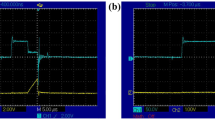Abstract
Different discharges occurring during machining in micro electrical discharge machining (MEDM) and its variants, viz. reverse MEDM (RMEDM) and wire EDM, affect the shape, size, surface roughness, and surface integrity of the generated surface. Of these different discharges, there are certain discharges with unusually high discharging points (well above open circuit voltage) during machining that have not been analysed till date. This study primarily aims in understanding the physical phenomenon behind occurrences of these unusual discharges specific to RMEDM process. This understanding should also hold good for MEDM and other electric discharge-based machining processes. A numerical model was developed taking into account the movement of ions and electrons in the dielectric during machining. The model predicted that the presence of ions only in the plasma discharge channel for a very short period of time during machining leads to occurrences of these unusually high discharging points (~170% of open circuit voltage, OCV) which was also verified from experiments (162–164% of OCV).













Similar content being viewed by others
References
Roy T, Datta D, Balasubramaniam R (2018) Numerical modelling and simulation of surface roughness of 3-D hemispherical convex micro-feature generated by reverse micro-EDM. Int J Adv Manuf Technol 97:979–992. https://doi.org/10.1007/s00170-018-1971-4
Kim BH, Park BJ, Chu CN (2006) Fabrication of multiple electrodes by reverse EDM and their application in micro ECM. J Micromechanics Microengineering 16:843–850. https://doi.org/10.1088/0960-1317/16/4/022
Mastud S, Singh RK, Joshi SS (2012) Analysis of fabrication of arrayed micro-rods on tungsten carbide using reverse micro-EDM. Int J Manuf Technol Manag 26:176. https://doi.org/10.1504/IJMTM.2012.051430
Singh AK, Patowari PK, Deshpande NV (2019) Analysis of micro-rods machined using reverse micro-EDM. J Brazilian Soc Mech Sci Eng 41:1–12. https://doi.org/10.1007/s40430-018-1519-4
Lyubimov VV, Volgin VM, Gnidina IV, Salomatnikov MS (2018) The discharge channel formation and the mechanism of material removal during electrical discharge micromachining by nanosecond pulses. Procedia CIRP 68:325–329. https://doi.org/10.1016/j.procir.2017.12.072
Shabgard M, Ahmadi R, Seyedzavvar M, Oliaei SNB (2013) Mathematical and numerical modeling of the effect of input-parameters on the flushing efficiency of plasma channel in EDM process. Int J Mach Tools Manuf 65:79–87. https://doi.org/10.1016/j.ijmachtools.2012.10.004
Ming W, Zhang Z, Wang S et al (2019) Comparative study of energy efficiency and environmental impact in magnetic field assisted and conventional electrical discharge machining. J Clean Prod 214:12–28. https://doi.org/10.1016/j.jclepro.2018.12.231
Mastud S, Singh RK, Samuel J, Joshi SS (2011) Comparative analysis of the process mechanics in micro electrical discharge machining and reverse micro EDM. In: Proc ASME 2011 Int Manuf Sci Eng Conf June 13–17, 2011, Corvallis, Oregon, USA, pp 1–10
Kao CC, Shih AJ (2006) Sub-nanosecond monitoring of micro-hole electrical discharge machining pulses and modeling of discharge ringing. Int J Mach Tools Manuf 46:1996–2008. https://doi.org/10.1016/j.ijmachtools.2006.01.008
Mahardika M, Mitsui K (2008) A new method for monitoring micro-electric discharge machining processes. Int J Mach Tools Manuf 48:446–458. https://doi.org/10.1016/j.ijmachtools.2007.08.023
Liao YS, Chang TY, Chuang TJ (2008) An on-line monitoring system for a micro electrical discharge machining (micro-EDM) process. J Micromechanics Microengineering 18:035009. https://doi.org/10.1088/0960-1317/18/3/035009
Nirala CK, Unune DR, Sankhla HK (2017) Virtual signal-based pulse discrimination in micro-electro-discharge machining. J Manuf Sci Eng 139:094501. https://doi.org/10.1115/1.4037108
Yang F, Bellotti M, Hua H, Yang J, Qian J, Reynaerts D (2018) Experimental analysis of normal spark discharge voltage and current with a RC-type generator in micro-EDM. Int J Adv Manuf Technol 96:2963–2972. https://doi.org/10.1007/s00170-018-1813-4
Mastud SA, Kothari NS, Singh RK et al (2014) Analysis of debris motion in vibration assisted reverse micro electrical discharge machining. In: Proceedings of the ASME 2014 International Manufacturing Science and Engineering Conference MSEC 2014
Newton TR (2008) Investigation of the effect of process parameters on the formation of recast layer in wire-EDM of investigation of the effect of process parameters on the formation of recast layer in wire-EDM of Inconel 718. Georgia Institute of Technology
Roy T, Datta D, Balasubramaniam R (2019) Debris based discharge segregation in reverse micro EDM. Measurement:107433. https://doi.org/10.1016/j.measurement.2019.107433
Xuyang C, Kai Z, Chunmei W et al (2015) A study on plasma channel expansion in micro-EDM. Mater Manuf Process 6914:150615134315006. https://doi.org/10.1080/10426914.2015.1059445
IIT Kharagpur, NPTEL (2009) Module 9: electro discharge machining
Roy T, Datta D, Balasubramaniam R (2018) Numerical modelling, simulation and fabrication of 3-D hemi-spherical convex micro features using reverse micro EDM. J Manuf Process 32:344–356. https://doi.org/10.1016/j.jmapro.2018.02.018
Acknowledgements
The authors are very grateful to Prof. P. Pawar, SVERI Pandharpur, for permitting the use of computational software package.
Funding source
This research did not receive any specific grant from funding agencies in the public, commercial, or not-for-profit sectors.
Author information
Authors and Affiliations
Corresponding author
Additional information
Publisher’s note
Springer Nature remains neutral with regard to jurisdictional claims in published maps and institutional affiliations.
Rights and permissions
About this article
Cite this article
Roy, T., Balasubramaniam, R. Influence of ion-rich plasma discharge channel on unusually high discharging points in reverse micro electrical discharge machining. Int J Adv Manuf Technol 106, 4467–4475 (2020). https://doi.org/10.1007/s00170-020-04934-6
Received:
Accepted:
Published:
Issue Date:
DOI: https://doi.org/10.1007/s00170-020-04934-6




